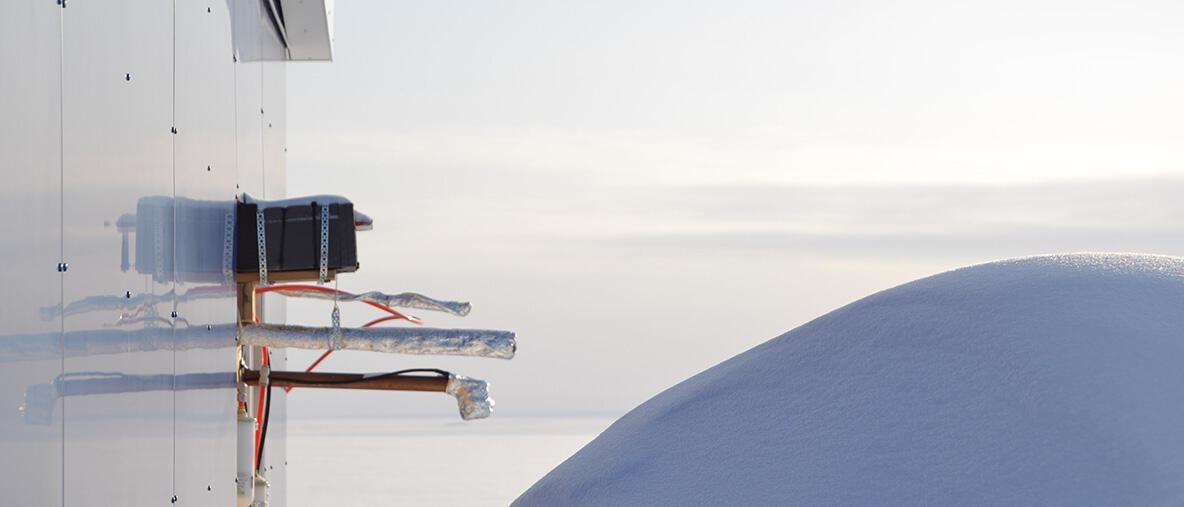Feb 1 2021
For the first time ever, scientists from the University of Helsinki have shown how the surrounding environment impacts the formation of nanoparticles in the Arctic. The findings provide a better understanding of the future of melting sea ice and the Arctic atmosphere.
 Measurements in Northern Greenland. Image Credit: Nina Sarnela.
Measurements in Northern Greenland. Image Credit: Nina Sarnela.
Scientists from the Institute for Atmospheric and Earth System Research at the University of Helsinki have examined how atmospheric particles develop in the Arctic. Studies so far have not been able to unravel the molecular processes of particle formation in the high Arctic.
As part of their expeditions to the Arctic, the researchers gathered measurements for 12 months. The findings of the comprehensive research project were reported recently in the Geophysical Research Letters journal.
The team found that atmospheric particles, vapors and cloud formation have obvious variations in several Arctic environments. The study elucidates how sea ice loss and warming in the Arctic reinforce the processes by which different vapors are discharged into the atmosphere. The sea ice thinning allows more iodine emissions and wider open waters allow increased emissions of sulfur-containing vapors.
The higher concentrations of vapors lead to a huge amount of particles. Alternatively, this will result in more clouds, which can either slow down or expedite the Arctic warming based on the location and season. Elaborate understanding of such processes is vital to gain better insights into the impacts of global warming.
Our observations are contributing to further understanding of what happens in the Arctic atmosphere due to warming. In general, atmospheric particles and clouds play an important role in regulating the atmosphere’s temperature, and any changing behavior of these has consequences on Arctic warming. Arctic areas are especially sensitive to changes in cloudiness and albedo.
Lisa Beck, Doctoral Student, Institute for Atmospheric and Earth System Research, University of Helsinki
More Information about the Future of Melting Sea Ice
The scientists carried out measurements in Svalbard at Ny-Ålesund and in Northern Greenland at Villum research station for around six months at each station. Although both sites are situated at similar latitudes, around 1000 km south of the North Pole, their surroundings are highly different. Sea ice surrounds Villum station throughout the year, whereas the warm sea currents make the sea near Ny-Ålesund to be open.
In Northern Greenland, the team found that in the spring following the Polar night, the microalgae beneath the sea ice began to discharge iodine compounds into the air. Throughout spring, the thinning sea ice results in the emission of still greater iodine compounds. Such compounds develop molecular clusters that can grow into huge particles.
In Svalbard, which is surrounded by open waters, the analyses revealed how sulfur compounds discharged by phytoplankton could develop a huge amount of particles that could grow rapidly, and can even develop cloud droplets. Organic compounds were also identified in the studies at Svalbard.
The team was fascinated by the huge amount and role of organic compounds in particle formation in the Arctic.
We did not expect to observe many organic vapors in the cold and bare Arctic environment as they have been mainly seen in areas covered by forests. We are planning to continue the studies in Svalbard to figure out what these organic compounds are and where they are coming from.
Lisa Beck, Doctoral Student, Institute for Atmospheric and Earth System Research, University of Helsinki
As far as Svalbard was concerned, the particle concentrations were higher when compared to those quantified in Northern-Greenland.
Currently, the Arctic sea ice is melting fast. As a result, we can assume that the processes observed in Svalbard will be more common in the Arctic areas that will be liberated from sea ice.
Lisa Beck, Doctoral Student, Institute for Atmospheric and Earth System Research, University of Helsinki
This study is associated with the recent Polarstern studies that have been continuing analyses in the high Arctic in the middle of sea ice regions.
Journal Reference
Beck, L. J., et al. (2020) Differing mechanisms of new particle formation at two Arctic sites. Geophysical Research Letters. doi.org/10.1029/2020GL091334.